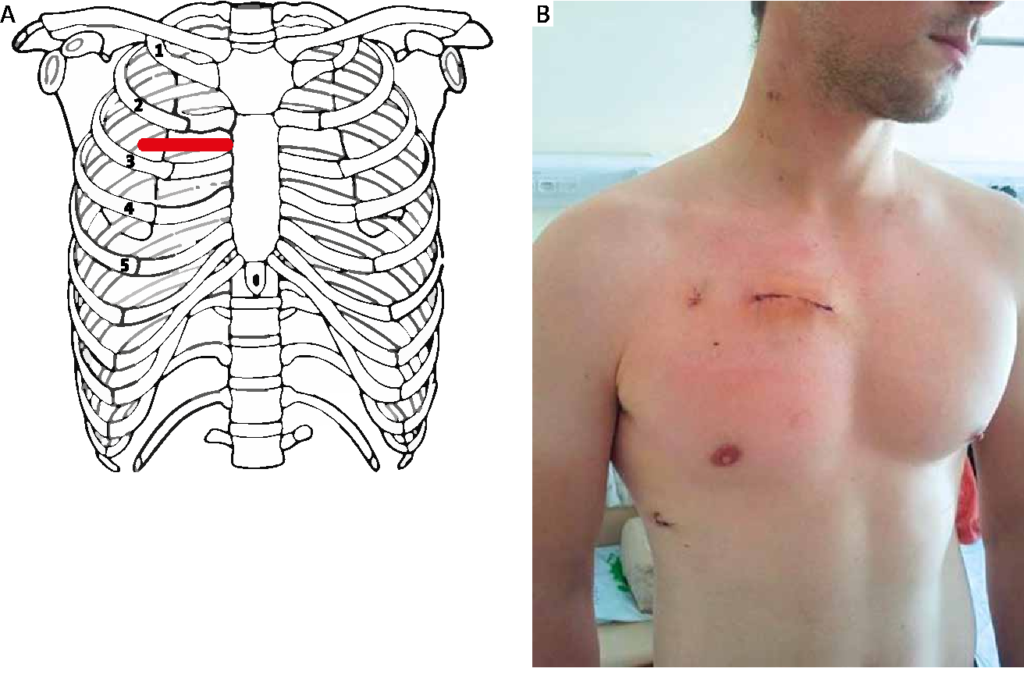Minimally Invasive Aortic Valve Replacement (MIAVR)

Minimally invasive aortic valve replacement (MIAVR) is a surgical procedure used to replace a diseased or damaged aortic valve with an artificial valve. It is called “minimally invasive” because it involves smaller incisions and less trauma to the patient compared to traditional open-heart surgery.
During MIAVR, the surgeon accesses the heart through small incisions in the chest, typically between the ribs, instead of making a large incision in the sternum (breastbone) as in traditional open-heart surgery. This approach allows for a more cosmetic result, reduced pain, shorter hospital stays, and faster recovery times.
The surgical techniques used in MIAVR can vary depending on the surgeon’s expertise and the specific case. One common approach is called a mini-sternotomy, in which a small incision is made in the upper part of the sternum. Another approach is a right anterior thoracotomy, where an incision is made on the right side of the chest between the ribs.
Once the incisions are made, the surgeon uses specialized instruments and a video-assisted system to access and replace the aortic valve. The damaged valve is removed, and an artificial valve, either mechanical or bioprosthetic, is inserted and secured in place. The surgeon then closes the incisions, and the patient is taken to the recovery area.
Minimally invasive aortic valve replacement offers several advantages over traditional open-heart surgery, including:
- Smaller incisions: Smaller incisions result in less scarring and reduced risk of infection.
- Reduced trauma: MIAVR causes less trauma to the chest, muscles, and other tissues, leading to less pain and a faster recovery.
- Shorter hospital stays: Patients undergoing MIAVR typically spend less time in the hospital, allowing them to resume normal activities sooner.
- Faster recovery: The reduced trauma and smaller incisions in MIAVR result in quicker healing and faster return to daily activities.
- Improved cosmetic outcome: The smaller incisions used in MIAVR are less noticeable, leading to a more aesthetically pleasing result.
Indications
Minimally invasive aortic valve replacement (MIAVR) may be considered as a treatment option for patients with certain indications. The specific indications can vary depending on the surgeon’s expertise and the patient’s individual case, but here are some common indications for MIAVR:
- Aortic valve stenosis: This is the most common indication for aortic valve replacement. Aortic valve stenosis occurs when the aortic valve becomes narrowed, restricting blood flow from the heart to the rest of the body. MIAVR may be considered for patients with severe aortic stenosis who require valve replacement.
- Aortic valve regurgitation: This condition occurs when the aortic valve does not close properly, leading to backward flow of blood into the heart. MIAVR can be an option for patients with significant aortic valve regurgitation who require valve replacement.
- High-risk or elderly patients: MIAVR is often considered for high-risk or elderly patients who may not tolerate traditional open-heart surgery well. Minimally invasive techniques can help reduce the risks associated with major surgery and promote faster recovery.
- Patient preference: Some patients may prefer the cosmetic benefits and faster recovery associated with MIAVR. If the patient is a suitable candidate and desires a minimally invasive approach, it can be considered.
Contraindications
While minimally invasive aortic valve replacement (MIAVR) offers several advantages, there are also certain contraindications that may make a patient unsuitable for this procedure. Some common contraindications for MIAVR include:
- Severe aortic calcification: Extensive calcification and hardening of the aortic valve and surrounding structures may make it difficult to perform MIAVR. Calcification can hinder the surgeon’s ability to access the valve and securely implant a replacement valve.
- Complex valve anatomy or pathology: Certain cases of aortic valve disease may have complex anatomy or pathology that make it challenging to perform MIAVR. This could include conditions such as heavily calcified or bicuspid valves, which may require a more extensive surgical approach.
- Significant coronary artery disease: If a patient has severe coronary artery disease that requires simultaneous bypass surgery (coronary artery bypass grafting or CABG), MIAVR may not be the preferred approach. In such cases, an open-heart surgery with a full sternotomy may be necessary to address both the aortic valve and coronary arteries.
- Previous chest surgeries: Patients who have undergone previous chest surgeries, particularly those involving the heart or lungs, may have scar tissue and anatomical changes that make MIAVR technically challenging or risky. The presence of adhesions and altered anatomy can complicate the procedure and increase the risk of complications.
- Hemodynamic instability or critical illness: MIAVR may not be suitable for patients who are hemodynamically unstable or critically ill. In such cases, a more invasive and immediate procedure, such as a traditional open-heart surgery, may be necessary to address the underlying condition.